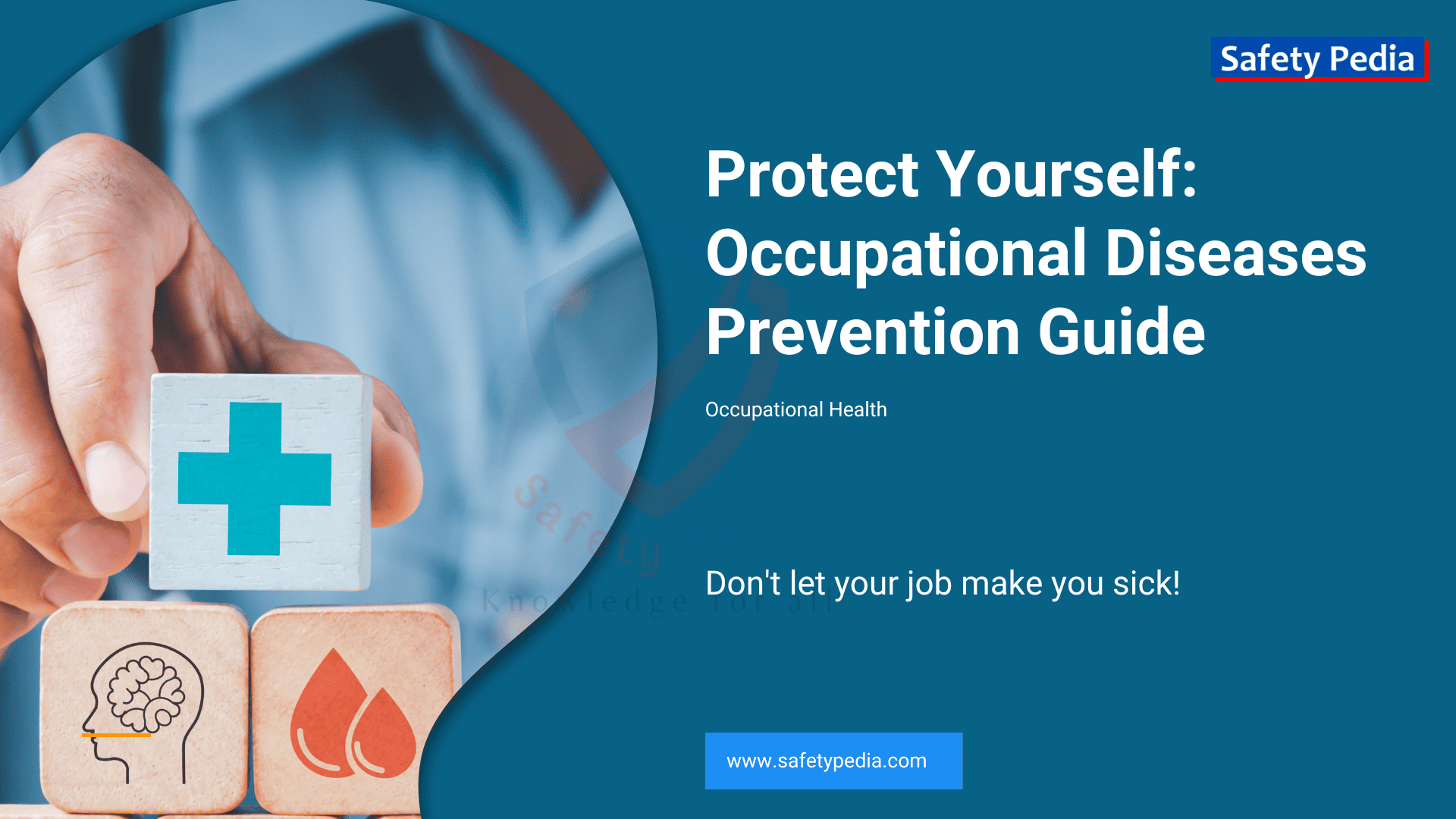Introduction – Occupational Diseases Prevention
Are you aware of the risks associated with occupational diseases? In today’s fast-paced work environments, it is crucial to prioritize your health and safety. That’s why we have created this comprehensive guide to help you protect yourself from occupational diseases. Whether you work in construction, manufacturing, healthcare, or any other industry, this guide is tailored to provide you with essential information and preventive measures.
Occupational diseases can have long-lasting effects on your health and can even be life-threatening. By understanding the hazards you may face in your workplace and implementing the necessary precautions, you can significantly reduce the risk of falling victim to these diseases.
We spend a significant portion of our lives working, and while work provides financial stability and personal fulfillment, it can also expose us to various hazards that can lead to occupational diseases. These are illnesses directly linked to our work environment and activities. While some are well-known, like silicosis in miners or carpal tunnel syndrome in office workers, many occupational diseases remain unrecognized or underreported.
In this guide, we will explore common types of occupational diseases, their causes, and potential preventive measures. From respiratory illnesses caused by exposure to hazardous substances to musculoskeletal disorders resulting from repetitive tasks, we will cover it all.
Your well-being is our utmost priority. So dive into this guide and arm yourself with the knowledge and strategies you need to protect yourself from occupational diseases. Safeguard your health today for a healthier tomorrow.
Early detection and intervention are crucial for managing occupational diseases.
Understanding Occupational Diseases
Occupational diseases are health conditions that result from exposure to hazards in the workplace. These diseases can have severe consequences on your health and well-being. It is essential to understand the risks associated with occupational diseases and take appropriate preventive measures.
Occupational diseases can manifest in various ways, ranging from respiratory illnesses caused by exposure to hazardous substances, such as asbestos or silica, to musculoskeletal disorders resulting from repetitive tasks. These diseases can significantly impact your quality of life and even be life-threatening if not addressed promptly.
To protect yourself from occupational diseases, it is crucial to be aware of the hazards present in your workplace. This knowledge will enable you to identify potential risks and implement preventive measures effectively.
Recognizing the Risks:
Identifying potential hazards in your workplace is crucial for prevention. Here are some red flags to be aware of:
- Exposure to hazardous substances: Dust, fumes, chemicals, solvents, and radiation found in various industries can irritate lungs, eyes, and skin, leading to respiratory problems, dermatitis, and even cancer.
- Biological hazards: Bacteria, viruses, and other pathogens present in healthcare, agriculture, and sanitation settings can lead to infectious diseases.
- Repetitive motions and awkward postures: Jobs requiring continuous use of specific muscle groups are at higher risk.
- Ergonomic deficiencies: Poorly designed workstations or tools can lead to MSDs.
- Loud noise levels: Noise exceeding safe limits can damage hearing.
- Lack of proper ventilation: This traps dust, fumes, and other contaminants in the air.
- Inadequate safety protocols: Missing or ineffective safety measures increase the risk of exposure.
- Psychological hazards: Stress, anxiety, and fatigue arising from work demands can negatively impact mental health and well-being.
Implementing Preventive Measures:
Now that you’re aware of the risks, here’s how to create a safer work environment:
- Hazard identification and assessment: Regularly evaluate your workplace for potential hazards and assess their severity and likelihood of causing harm.
- Engineering controls: Implement measures like ventilation systems, noise barriers, and ergonomic workstations to minimize exposure at the source.
- Administrative controls: Develop policies and procedures to limit exposure time, rotate tasks to reduce repetitive motions, and provide adequate personal protective equipment (PPE) when necessary.
- Employee education and training: Equip your workforce with the knowledge and skills to recognize hazards, use PPE properly, and report any concerns promptly.
- Regular monitoring and evaluation: Continuously monitor the effectiveness of your preventive measures and make adjustments as needed.
Prevention is always cheaper and more effective than treating occupational diseases.
What is Occupational Health?
Occupational health is an essential area of work within public health that aims to promote and maintain the highest degree of physical, mental, and social well-being for workers across all occupations. Its objectives encompass several critical aspects:
- Maintenance and Promotion of Workers’ Health and Working Capacity: Occupational health focuses on ensuring that workers remain healthy, productive, and capable of performing their job duties effectively.
- Improvement of Working Conditions and Environment: The goal is to create a work environment that fosters safety and health. This includes addressing physical hazards, ergonomic concerns, and other factors that impact workers’ well-being.
- Development of Work Organization and Cultures: Occupational health emphasizes adopting value systems that prioritize safety and health. Effective managerial

Common Types of Occupational Diseases
Occupational diseases can affect individuals across different industries. Understanding the common types of occupational diseases can help you recognize the symptoms and take appropriate action to protect yourself.
- Respiratory Illnesses: Exposure to airborne substances like dust, chemicals, or fumes can lead to respiratory conditions such as asthma, chronic obstructive pulmonary disease (COPD), or occupational lung diseases.
- Musculoskeletal Disorders (MSDs): Repetitive motions, heavy lifting, or poor ergonomic practices can cause MSDs, including carpal tunnel syndrome, tendinitis, or back pain.
- Hearing Loss: Prolonged exposure to high noise levels in industries like construction, manufacturing, or entertainment can result in permanent hearing loss.
- Skin Diseases: Contact with chemicals, irritants, or allergens can lead to skin conditions like dermatitis, eczema, or occupational skin cancer.
- Mental Health Disorders: Work-related stress, long hours, or exposure to traumatic events can contribute to mental health issues such as anxiety, depression, or post-traumatic stress disorder (PTSD).
- Cancer: Certain chemicals and radiation can increase the risk of various cancers.
The Impact of Occupational Diseases on Workers and Employers
Occupational diseases not only affect individual workers, employers but also have significant consequences for society and the overall productivity of a workplace.
Impact on Workers:
- Physical and mental health: Occupational diseases can range from mild skin irritations to debilitating conditions like cancer and respiratory illnesses. These can lead to chronic pain, disability, and even premature death, impacting workers’ quality of life and well-being.
- Financial strain: Medical bills, lost wages due to illness or disability, and reduced earning potential can create significant financial hardship for affected workers and their families.
- Psychological impact: The fear of contracting a disease, dealing with pain and disability, and the uncertainty of the future can cause stress, anxiety, and depression, further impacting mental health.
- Job insecurity: Chronic illness or disability may lead to job loss or difficulty finding new employment, further exacerbating financial strain and emotional stress.
Impact on Employers:
- Increased costs: Medical expenses, disability compensation, lost productivity due to absenteeism and presenteeism (reduced worker efficiency), and increased turnover can significantly impact an employer’s bottom line.
- Legal repercussions: Failure to provide a safe work environment can lead to lawsuits, fines, and reputational damage, further exacerbating financial burdens.
- Reduced morale and productivity: A workforce worried about their health is less likely to be engaged and productive, impacting overall business performance.
- Reputational damage: Public awareness of occupational diseases within a company can harm its reputation, affecting customer loyalty, employee recruitment, and overall brand image.
Impact on Society:
- Healthcare costs: The burden of treating occupational diseases falls on healthcare systems, increasing public expenditure.
- Lost productivity: Reduced workforce participation due to illness or disability impacts national productivity and economic growth.
- Ethical concerns: The ethical implications of exposing workers to health hazards highlight the need for stronger regulations and preventative measures.
- Social Inequality: Occupational diseases often disproportionately affect low-wage and marginalized workers, exacerbating existing inequalities.
Preventing Occupational Diseases:
The good news is that many occupational diseases are preventable. Employers and employees share a responsibility to create a safe and healthy work environment. Here are some key strategies:
For employers:
- Implement comprehensive hazard identification, risk assessment, and control programs.
- Provide appropriate personal protective equipment (PPE) and training on its safe use.
- Ensure proper ventilation and dust control measures.
- Encourage ergonomic assessments and workstation adjustments.
- Offer health and safety training programs and regular safety briefings.
- Promote healthy work habits and encourage breaks.
- Establish effective reporting and investigation systems for occupational injuries and illnesses.
For employees:
- Be aware of potential hazards in your work environment.
- Use PPE as instructed and report any damage or malfunction.
- Follow safe work practices and procedures.
- Report any safety concerns or health issues to your supervisor.
- Participate in safety training and ask questions if unclear.
- Maintain good posture and take breaks to avoid MSDs.
- Seek medical attention if you experience any work-related health symptoms.
Occupational Diseases Prevention Strategies
Preventing occupational diseases requires a proactive approach that involves identifying hazards, implementing preventive measures, and fostering a culture of safety in the workplace. Here are some effective strategies to protect yourself:
Importance of Workplace Safety Measures
Creating a safe work environment is the first line of defense against occupational diseases. Employers should prioritize safety by implementing safety protocols, conducting regular risk assessments, and providing training to employees on hazard identification and mitigation.
Personal Protective Equipment (PPE) and Its Role in Preventing Occupational Diseases
Personal protective equipment (PPE) plays a vital role in protecting workers from occupational hazards. Employers should provide appropriate PPE, such as gloves, masks, goggles, or earplugs, and ensure proper training on their use and maintenance.
Effective Hygiene Practices to Prevent Occupational Diseases
Maintaining good hygiene practices can help prevent the spread of infectious diseases and exposure to harmful substances. Workers should practice regular handwashing, proper disposal of waste, and cleanliness in personal workspaces.
Regular Medical Check-ups and Early Detection of Occupational Diseases
Regular medical check-ups are essential for early detection of occupational diseases. Workers should undergo periodic health screenings to identify any potential health risks and take appropriate action before the condition worsens.
Training and Education for Occupational Disease Prevention
Education and training are crucial for raising awareness about occupational diseases and promoting preventive measures. Employers should provide comprehensive training programs, safety guidelines, and resources to empower employees to protect themselves.
Conclusion: Taking Responsibility for Your Health and Safety at Work
Protecting yourself from occupational diseases requires a proactive approach that involves understanding the risks, implementing preventive measures, and advocating for a safe work environment. By prioritizing your health and safety, you can enjoy a healthier tomorrow and reduce the risks associated with occupational diseases. Remember, your well-being is paramount, so take the necessary steps to protect yourself today.
Disclaimer: This blog is intended for informational purposes only and is not a substitute for professional medical advice. Please consult a healthcare professional if you have any concerns about your health.
References:


THIS MESAGE IS VERY NICE TO CHANGE CONSTRUCTION WORKERS MIND FOR THEIR CONTINOUSLY LIFE AND SUCCESS